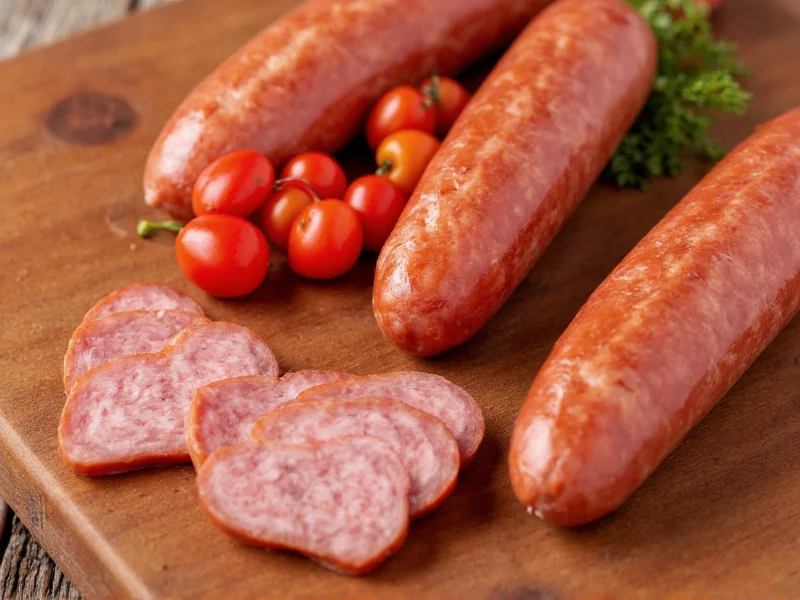German sausage culture represents one of the world's most sophisticated meat traditions, with regional specialties developed over centuries. Unlike mass-produced sausages found elsewhere, authentic german sausage types showcase remarkable diversity in texture, seasoning, and preparation methods. This culinary heritage earned Germany the nickname "Wurstparadies" (sausage paradise) among food enthusiasts.
The Cultural Significance of German Sausage Traditions
Sausage making in Germany dates back to Roman times, with documented evidence from the 9th century. Each region developed unique varieties based on local ingredients, climate conditions, and cultural influences. The Nürnberger Bratwurst from Bavaria, for example, received Protected Geographical Indication (PGI) status from the European Union in 2003, recognizing its authentic regional production methods.
German sausage traditions serve as cultural markers—certain varieties appear only in specific regions during particular seasons. In Bavaria, Weisswurst traditionally appears only before noon (Weisswurstfrühstück), while northern regions favor Knackwurst and Bockwurst. This regional specialization explains why Germany maintains such an extraordinary variety of traditional german sausage varieties.
Four Fundamental Categories of German Sausages
German sausages fall into four primary classifications based on preparation method:
| Category | Preparation Method | Shelf Life | Key Examples |
|---|---|---|---|
| Brühwurst | Parboiled in water (70-80°C) | 2-3 days refrigerated | Weisswurst, Bockwurst, Frankfurter |
| Rohwurst | Raw fermented sausage | Several weeks | Salami, Teewurst |
| Kochwurst | Fully cooked sausage | Several weeks refrigerated | Leberwurst, Blutwurst |
| Rohwurst (cured) | Air-dried raw sausage | Months | Landjäger, Mettwurst |
Essential German Sausage Varieties Explained
Bratwurst: Germany's Most Famous Export
While often considered a single type, bratwurst actually encompasses over 40 regional varieties. The Nürnberger Bratwurst (protected by PGI) measures just 7-9 cm long with a distinctive marjoram seasoning. Thüringer Rostbratwurst (also PGI-protected) features caraway and mustard seeds, traditionally grilled over beechwood.
Differences between regional bratwurst types extend beyond size and seasoning. Southern varieties typically use veal and pork, while northern versions incorporate more pork. Authentic german sausage recipes for bratwurst always specify natural casings—usually sheep intestine—which provide the characteristic "snap" when cooked.
Weisswurst: Bavaria's Breakfast Specialty
The iconic Weisswurst (white sausage) represents Bavaria's culinary heritage. Made from minced veal and back bacon with parsley, lemon, mace, and cardamom, it's never smoked or cured. Traditional preparation involves simmering in water (never boiling) for exactly 10 minutes. Locals follow the "Zuzeln" method—slipping the meat from the casing—rather than biting directly into the sausage.
Currywurst: Germany's Beloved Street Food
Invented in Berlin in 1949, Currywurst transformed German street food culture. This dish features a Brühwurst (typically Bratwurst or Knackwurst) sliced and topped with a distinctive curry-spiced ketchup. Regional variations abound: Berliners prefer a spicier sauce, while Ruhr Valley versions include vinegar notes. In 2019, Germans consumed approximately 800 million currywursts—a testament to its national popularity.
Blutwurst and Leberwurst: Traditional Blood and Liver Sausages
Blutwurst (blood sausage) and Leberwurst (liver sausage) represent Germany's nose-to-tail eating tradition. Northern regions favor Flönz—a soft, spreadable blood sausage—while southern versions incorporate more spices. Traditional german sausage recipes for Blutwurst use fresh pig's blood, onions, and bacon, often served sliced with boiled potatoes and apple sauce.
Regional Sausage Specialties Across Germany
Germany's federal structure fostered remarkable regional diversity in sausage production. Understanding these distinctions reveals why types of german sausages vary so dramatically:
- Bavaria: Weisswurst, Nürnberger Bratwurst, Leberkäse (meatloaf, not actually sausage)
- Thuringia: Thüringer Rostbratwurst (PGI), Rostbratwurst mit Sauerkraut
- Rhineland: Currywurst, Currywurst mit Pommes, Dörfchen (small smoked sausage)
- Saxony: Leipziger Allerlei mit Bratwurst, Presskopf (head cheese)
- Westphalia: Westfälische Mettwurst, Pumpernickel mit Leberwurst
- Hamburg: Aalsuppe mit Räucherspeck (fish soup with smoked sausage)
Authentic German Sausage Preparation Methods
Traditional german sausage making follows precise methods developed over generations. Key elements include:
- Meat selection: Regional sausages use specific cuts—Weisswurst requires premium veal shoulder, while Blutwurst uses coarsely ground pork
- Seasoning precision: Authentic recipes specify exact spice ratios; Nürnberger Bratwurst requires precisely 0.6g of mace per kilogram
- Casing traditions: Natural casings (sheep for small sausages, pig for larger) remain standard for protected varieties
- Temperature control: Brühwurst must cook below 80°C to maintain texture
Modern industrial production has created imitations, but protected regional varieties (like Nürnberger Bratwurst PGI) must follow strict traditional methods. This explains why finding authentic german sausage recipes outside Germany often proves challenging—the precise regional techniques rarely translate well across borders.
Serving Traditions and Cultural Significance
German sausage culture extends beyond the product to encompass specific serving traditions:
- Weisswurstfrühstück: Bavarian white sausage breakfast served before noon with sweet mustard and pretzels
- Currywurst mit Pommes: Berlin's iconic street food pairing with fries
- Bratwurstsemmel: Nuremberg's simple sandwich of bratwurst in a roll with mustard
- Wurstsalat: Swabian specialty of sliced sausages in vinegar dressing
Regional mustard varieties play crucial roles—Bavarians prefer sweet mustard with Weisswurst, while Nuremberg uses sharp Dijon-style mustard with bratwurst. Beer pairings also follow regional patterns: Weisswurst traditionally accompanies wheat beer (Weißbier), while smoked sausages pair with darker lagers.
Identifying Authentic German Sausages
When seeking traditional german sausage varieties outside Germany, look for these authenticity markers:
- Protected designation labels (PGI): Nürnberger Bratwurst, Thüringer Rostbratwurst
- Natural casings (avoid plastic or collagen casings)
- Short ingredient lists without fillers or preservatives
- Regional specialty butchers rather than mass-market producers
- Traditional preparation methods (ask about cooking techniques)
Authentic german sausage recipes rarely include breadcrumbs or excessive fillers—traditional varieties rely on meat quality and precise seasoning. When purchasing, examine texture: genuine Bratwurst should have a coarse grind, while Weisswurst maintains a smooth, emulsified consistency.











 浙公网安备
33010002000092号
浙公网安备
33010002000092号 浙B2-20120091-4
浙B2-20120091-4